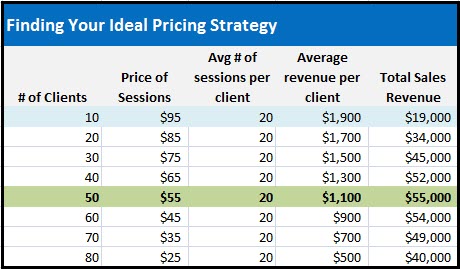15 Advertising Tricks to Sell Food Online (+examples)
If you sell food online, you have found the right article. I work in marketing and advertising for a wonderful […]
Read More »Become a successful marketing consultant: Learn more

You can be certain about one thing:
Your customers will respond to your price, whether they show up at your doorstep with money in hand, or they are compelled to find other options.
There are three primary factors that will determine how your target market responds to any pricing strategy. The three factors are:
Understanding how these three factors contribute to an effective pricing strategy is critical for you to locate the "sweet spot" -- the price point(s) that will help you maximize profits while keeping your customers happy and coming back.
In this screenshot, notice the optimal price per session. It isn't the highest price per session at $95, and it's not the lowest price per session at $25. Its the $55 per session that contributes the most total sales revenue because it's the sweet spot.
If you have been in business for any amount of time, it is likely you have heard how important customer demographics are.
It's the demographics that can have a major impact on choosing your product and service specializations.
Dictionary.com defines demographics as the statistical data of a population, especially those showing average age, income, education, etc.
For example, if you want to sell pool cleaning supplies and services to high income neighborhoods, then your demographics may consist of 40+ year-old male and female business owners and professionals who live within 10 miles of your location, have household incomes of $80,000 a year or more and residential lots of 15,000+ square feet.
Defining your demographics -- the selection of the target market -- is the first and most important step to a successful pricing strategy.
Once you have defined your demographic parameters, you can now investigate the second main factor in your pricing strategy: psychological factors.
The final primary factor in your pricing strategy is called price elasticity.
Price elasticity is a measure of how the customer will respond to price increases and price decreases, as well as the number of available substitutes taking sales away from your product or service.
When prices go up, sales go down because customers are sensitive to higher prices and don’t want to pay them. This is an example of a price elastic offer.
The opposite is true, too. When prices go down, because of price elasticity, sales go up because the customer is price sensitive.
The below screenshot is an example of the number of customers served going down as prices go up. On the other hand, the opposite of price elasticity is price inelasticity, where consumers are generally not sensitive to a change in prices. If this were the case for massage therapy sessions, then the number of clients would stay the same as price increases -- in other words, customers would not be sensitive to a price increase in an inelastic environment.
On the other hand, the opposite of price elasticity is price inelasticity, where consumers are generally not sensitive to a change in prices. If this were the case for massage therapy sessions, then the number of clients would stay the same as price increases -- in other words, customers would not be sensitive to a price increase in an inelastic environment.
A classic example of a price inelastic product is gasoline. For the most part, consumers will still buy gasoline regardless of the changes in price. That's because there really are no quality substitute products for gasoline because drivers still need gasoline in their car.
The reality is that most products and services are subject to price elasticity for at least two reasons:
There are methods to measure price sensitivity, although it is most important for you to be aware of the general principle.
An economist would estimate price elasticity using a fairly clunky formula: by diving relative changes in the quantity sold by relative change in price. No need for you to do this.
You can easily gauge how your clients respond to price changes by reviewing your customer base and your historical prices (or of someone you know). Also by asking a group of customers some simple questions about how they react to changes in your prices (or your competitors).
These activities can give you some wonderful insight into how sensitive they are to pricing.
About Your Strategic Marketing Partner
Sam Hirschberg, MBA, is Your Strategic Marketing Partner in Arizona. Always professional and a delight to work with, Sam is not your typical “marketing consultant”. Unlike most consultants who tell you there is a problem and say, “See you later and good luck!” Your Strategic Marketing Partner knows how to find solutions, execute programs, test and measure campaigns, and how-and-when it’s time to roll-out big! You are invited to call (602) 892-0777 to learn more about Sam’s background on his FREE 9-minute recorded message. For more information about Sam, please visit https://strategicmarketingpartner.com.